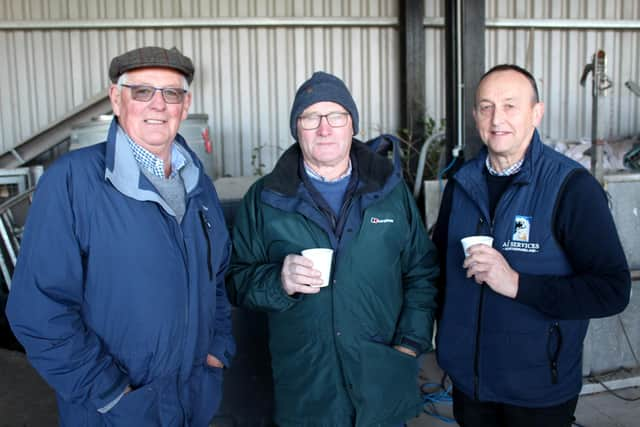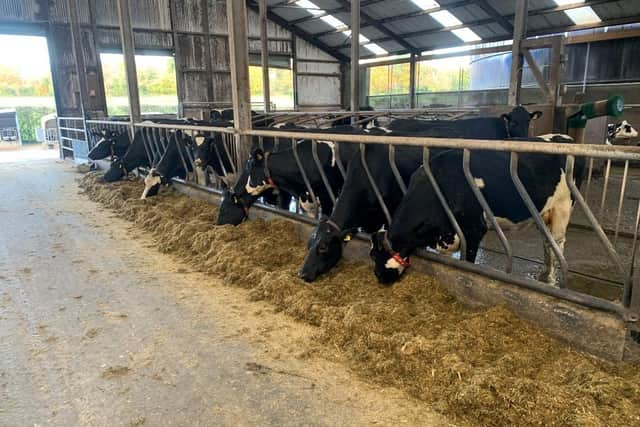Ulster Grassland Society members visit Drayne’s Farm
and live on Freeview channel 276
The business sells a mix of liquid milk and ice cream to shops, hotels and public sector bodies across Northern Ireland.
Company partner, Michael Drayne, addressed UGS members.
He confirmed that the business processes 7M litres of milk on an annual basis, adding:


Advertisement
Advertisement
“We produce around 1M litres of milk from our own cows: the rest we buy in from Ballyrashane Creamery, now part of Lakeland Dairies.
“We have been reasonably successful in maintaining the prices that we receive over recent months. But this is not an easy process.
“For example, when supplying the likes of the health sector, we enter into fixed price contract arrangements that cannot be changed for an agreed period of time.
“There is also a fundamental requirement to invest in the processing side of the business on a continuous basis.


"And all of this comes at a significant cost.”
Advertisement
Advertisement
Approximately 60% of the milk processed at Drayne’s Farm is sold in semi-skimmed form: the rest is made available as a full fat option.
Michael Drayne again:
“Improving the overall sustainability of the business is critically important as we look to the future.
“Our aim is to secure carbon neutrality by 2040.”
Solar panels, fixed to a number of the roofs at Draynes’ Farm currently supply 40% of the electricity required by the company.
“The electricity generated by the panels varies greatly depending on the time of year and the sunshine levels from day-to-day,” confirmed Michael Drayne.
Advertisement
Advertisement
“The plan is to double the footprint of the panels over the coming months.
"This should mean that we can secure 80% of the electricity that we need using solar technologies.
“The cost of solar panels has come down considerably.
"And, obviously, this is important in making them a viable option for us.”
Drayne’s Farm was established by the family in 1932.
The proximity of Lisburn made the option of the supplying homes and businesses in the town with fresh milk a feasible one.
Advertisement
Advertisement
Organic growth has been achieved by the business over the past 91 years.
“Doorstep delivery was critically important in the early days.
"But back then there were strict controls on prices,” Michael commented.
“So, we had to ask government to allow any price increase that we would have wanted to make.”
Advertisement
Advertisement
As the years passed the sophistication of the Drayne’s Farm business increased. Horses and carts gave way to electric floats, which were replaced by a larger, temperature-controlled diesel lorry fleet.
“The entry of the supermarkets marked the beginning of the end for doorstep deliveries,” Michael Drayne explained.
“However, over a forty-year period we had managed to build up a customer base in the Lisburn area that would have challenged for top market spot.
“And we have always been extremely grateful for the support given to us in this way.”
Advertisement
Advertisement
The ending of the doorstep delivery service saw Drayne’s Farm switching to supply local shops.
Entry into the Belfast market was secured on the back of a supply agreement reached with the Costa Coffee franchise.
Subsequent to this, the business started supplying milk to coffee shops in the Newry area.
Michael Drayne continued:
“It’s funny how developments can take place within a business. There’s a lot of hype today about the benefits of electric vehicles.
Advertisement
Advertisement
“At one stage we had 10 electric floats servicing customers in the Lisburn area.
“But the drawback was the maximum speed: 15mph. As a result, they annoyed a lot of people due to disruption, particularly at rush hour.”
The Drayne’s main milk plant currently runs at 5,000L per hour: producing full skim (1% fat), semi-skimmed and whole milk.
The company also produced whipping and double cream.
An ice cream plant pasteurises 300L of milk per hour.
A recent investment in a 770L continuous freezer will allow more ice cream to be produced on a daily basis.
Advertisement
Advertisement
According to Michael Drayne, bringing the ice cream temperature quickly down to -40°C improves both the texture and the shelf life of the product.
Drayne’s Farm employs a total of nine full-time staff within its processing operation. A further 18 people are employed in product distribution.
Backing this up are an additional seven staff, employed in a sales, administrative and management capacity.
Further investment within the business is in train for 2024.
Advertisement
Advertisement
This will include a doubling of the main milk processing plant from 5,000L to 10,000L per hour.
“We need more processing capacity, particularly in the run-up to the weekend,” Michael Drayne explained.
“The core objective is to improve the overall efficiency of the business.”
He concluded:
“Everything started with the cows on the farm.
"And they are still a fundamental driver for the business. Customers have the opportunity to visit the farm and view the cows.”
Silage slippage
Advertisement
Advertisement
Silage slippage is a major challenge on many farms in Northern Ireland at the present time, according to John Thompson and Sons’ nutritionist, Mary-Jane Robinson.
She confirmed the trend courtesy of her presentation to Ulster Grassland Society (UGS) members, who recently visited Drayne’s Farm.
Robinson attributed the slippage issue to a combination of factors.
Two of these are: the ensiling of wet forages and poor clamp consolidation.
Advertisement
Advertisement
Turning to the information available to farmers in silage analysis reports, the nutritionist highlighted two specific forage quality characteristics: AD Lignin and Ash percentage.
She said:
“The AD Lignin value reflects the amount of totally indigestible fibre within a forage. This becomes an issue in terms of a silage’s intake potential if this value goes above 40g/kg.
“Ash percentage is an indicator of soil contamination within a silage, if the value exceeds 10.0. Again, forage intakes can be reduced under these circumstances.”
Robinson also highlighted the Lactic Acid values within silages.
She commented:
Advertisement
Advertisement
“These figures reflect the impact that silages can have on rumen function. So we need to be mindful of this information when it comes to balancing cow diets.”
Turning to spring wholecrop forages made in Northern Ireland this year, the nutritionist pointed to a trend of lower dry matter and starch values this year relative to what would be normally expected.
There is some expectation, however, that winter whole crops may be of a higher nutritive value.
Currently three cuts of silage are made at Drayne’s Farm.
Mary-Jane Robinson again:
“The plan is to push this up to four cuts annually.
"Research has confirmed that taking this approach consistently improves D Values throughout the year.
Advertisement
Advertisement
“Achieving this will have a direct and positive impact on milk components.”
Where the concentrate component of rations fed to dairy cows are concerned, the nutritionist highlighted the value of feeding cereals at the present time.
This works at two levels: cereals have a high energy density and they are also relatively cheap at the present time.
The nutritionist also confirmed the enhanced risk of mycotoxins in silages this year.
Robinson concluded:
Advertisement
Advertisement
“This trend has become increasingly apparent over the past number of years. Where the feeding of high merit dairy cows is concerned, the inclusion of a binder in diets is strongly recommended.”
Improved milking speeds
Breeding cows with improved robotic milking speeds will allow an expansion of the dairy herd at Drayne’s Farm.
The farm attached to the family-owned milk processing business – located on the outskirts of Lisburn in Co Antrim – is home to 120 Holstein cows.
They are milked through three Lely robots. The plan is to bring the herd up to 170 cows with associated young stock while retaining the same number of robotic milking points.
Drayne’s farm manager, Chris Wright explained:
“Our average milking speed is currently 1.9L/minute.
Advertisement
Advertisement
"The scope to bring this figure up to 2.9L exists. We have identified the group of animals within the herd that are slow milkers.
“The plan is to breed their bloodlines out of the milking group and replace these with young stock that are genetically programmed to milk faster within a robotic system.
“By taking this approach we should also be able to significantly improve the number of cows being milked on the farm the year-round.”
Currently two of the robots are set up as total confinement system.
Advertisement
Advertisement
However, the third has been configured to allow in-calf cows out to graze during the spring and summer months.
One of the robots is dedicated to freshly calved heifers only.
Cow rumination and heat detection rates are also monitored on a continuous basis.
The Drayne herd is currently averaging 33kg of milk per day across an average of 3.1milkings.
Current butterfats are 4.2% with milk proteins at 3.38%.
Advertisement
Advertisement
The average Somatic Cell Count (SCC) for the milking group is 140.
The rolling herd concentrate feed rate is currently sitting at 0.39kg/L.
From a breeding perspective sexed semen is used on maiden heifers plus the top performing cows in the group.
A maximum of two sexed straws will be used per animal, after which the shift will be made to beef semen.
Advertisement
Advertisement
Maiden heifers are synchronised at 13-14 months of age, aiming for a 24-month age at first calving date.
Triple-beef cocktail straws are used on all the other breeding animals. Bull calves are sold off the farm at an early age.
The current dairy breeding programme has a strong focus on increased longevity and lifetime yield. Improving fat, protein and milking speed are also key drivers for the future. Breeding cows that are suitable for a robotic system is also a priority.
A small amount of Viking Red semen has been used on the Drayne herd with the first calves now on the ground. The calving interval for the herd currently stands at 393 days. Animals are vaccinated for IBR, BVD and Leptospirosis.
Advertisement
Advertisement
Herd replacements are wormed and fluked on the back of veterinary advice.
Cows are wormed and fluked during their dry periods.
About: Back in 1932 when Seamus Drayne and his two brothers Aidan and Dermot started Draynes Farm, the Glenavy Road was in the heart of the country. They saw a market opportunity in the developing town that was on their doorstep.
Eighty years or so down the road, and Lisburn has changed a lot. It’s nearer to the farm for a start, but that has helped to bring the business even closer to one of its main markers. And it’s not just Lisburn that’s changed. Seamus, Aidan and Dermot would hardly recognise the farm…or at least not the buildings and the technology.But what they would recognise is the passion for modern dairy farming that still runs through everything they do at Draynes Farm. That’s because they remain an independent family business producing, processing and distributing directly from the 200 acre farm in Lisburn.And the Drayne family today think Seamus, Aidan and Dermot would feel proud that the business they started all those years ago, is still delivering the finest home grown milk and cream to thousands of homes and businesses in Lisburn and across Northern Ireland.